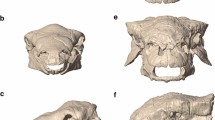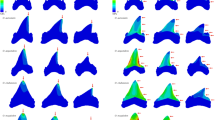Abstract
Ancient terrestrial tetrapod ecosystems of the Permian Period document the expansion and diversification of the earliest carnivore guilds containing highly specialised killers. These predators were synapsids, the ancient ancestors of mammals. Determining the mode of life of fossils such as synapsids is fraught with difficulties. But developments in the past twenty years provide rigorous new approaches for ascertaining habit in extinct tetrapods. A synthetic-analytical coupling of appropriate experimental data with the hybrid numerical computer technique Finite Element Analysis (FEA) gives a robust interpretation of synapsid morphology. Applying these techniques to Late Permian predators refines our knowledge of carnivore habit and niche separation at this crucial stage in carnivore evolutionary history. The Synapsida dominated late Permian terrestrial ecosystems, and forms such as lycosuchids, scylacosaurids and gorgonopsids composed the bulk of the tetrapod predators. Their postcranial skeletons are very similar and provide few indications of ecological partitioning; synapsid skulls however show a great diversity of form.
Unlike many extinct tetrapods such as dinosaurs, synapsids are structurally closely comparable to a group of living amniotes: mammals. This is crucial as extensive experimental data on skull structure in mammals can be appropriately applied to synapsid cranial anatomy in a meaningful way. This is less so in, for example a scaled-up use of lizard skulls to interpret cranial function in theropod dinosaurs. Of particular use in this analysis of synapsid crania are the detailed experimental analyses of jaw and skull design in living primates. Stress-strain analyses of the mandible in primates allow a rigorous interpretation of jaw function in synapsids. This approach reveals some hitherto unknown aspects of the morphology and hence potential niche separation of these carnivores during the Permo-Triassic extinction event. In at least one instance, niche filling appears to have been based on a specific trophic ecotype: the gorgonopsid — moschorhinid convergence. The data is tied together by using FEA to examine stress patterns in fossil skulls. By using a synthetic-analytical approach, an interpretation of the cranial morphology of synapsid carnivores is produced of sufficient depth so that their niche separation based on predatory capability can be elucidated. Results provide insights into aspects of Permo-Triassic synapsid predator communities.
Similar content being viewed by others
References
Anderson, J. M. &Cruickshank, A. R. I. (1978): The biostratigraphy of the Permian and the Triassic. Part 5. A review of the classification and distribution of Permo-Triassic tetrapods. Palaeontologia Africana.21: 15–44.
Benton, M. J. (1993): The fossil record II. Chapman & Hall. London.
Benton, M. J,Shishkin, M. A.,Unwin, D. M. &Kurochkin, E. N. (2000): The age of dinosaurs in Russia and Mongolia. — Cambridge University Press.
Biknevicius, A. R. &Van Valkenburgh, B. (1996): Design for Killing: Craniodental Adaptations of Predators. In:Gittleman, J. L. [ed]. Carnivore Behaviour, Ecology and Evolution Vol.2. Cornell University Press; Ithaca.
Biknevicius, A. R., Van Valkenburgh, B. &Walker. J. (1996): Incisor size and shape: implications for feeding behaviours in saber-toothed “cats”. Journal of Vertebrate Paleontology.16 (3): 510–521.
Briggs, D. E. G. &Crowther, P. R. (1990): Palaeobiology: a synthesis. — Blackwell Scientific Oxford.
Broom, R. (1930): On the structure of the mammal-like reptiles of the suborder Gorgonopsidae. Philosophical Transactions Royal Society. London. B.218: 345–371.
Broom, R. (1932): The mammal-like reptiles of South Africa and the origin of mammals. — H. F. & G. Witherby. London.
Broom, R. (1936): On the structure of the skull in the mammal-like reptiles of the suborder Therocephalia. Philosophical Transactions Royal Society. London. B.226: 1–42.
Buckland-Wright, J. C. (1971): The shock-absorbing effect of cranial sutures in certain mammals. Journal of Dental Research. Supplement to No 5. Abstract. 1168.
Buckland-Wright, J. C. (1978): Bone structure and the patterns of force transmission in the cat skull (Felis catus): Journal of Morphology.155 (1): 35–62.
Busbey, A. B. (1995): The structural consequences of skull flattening in crocodilians. In:Thomason, J. J. [ed]. Functional Morphology in Vertebrate Paleontology. pp. 173–192. — Cambridge University Press.
Carroll, R. L. (1988): Vertebrate Paleontology and Evolution. — W.H.Freeman and Co. New York.
Covey, D. S. G. &Greaves, W. S. (1994): Jaw dimensions and torsion resistance during canine biting in the Carnivora. Canadian Journal of Zoology.72: 1055–1060.
Durand, J. F. (1991): A revised description of the skull of Moschorhinus (Synapsida, Therocephalia): Annals South African Museum.99 (11): 381–413.
Feder, M. &Lauder, G. V. (1986): Predator-prey relationships: perspectives and approaches from the study of lower vertebrates. — Chicago Press.
Gittleman, J. L. [ed]. (1989): Carnivore Behaviour, Ecology and Evolution. Vol 1. — Cornell University Press; Ithaca.
Gittleman, J. L. [ed]. (1996): Carnivore Behaviour, Ecology and Evolution. Vol 2. 644 pp. Cornell University Press; Ithaca.
Herring, S. W. (1972): Sutures — a tool in functional cranial analysis. Acta Anatomica.83: 222–247.
Herring, S. W. (1998): How can animal models answer clinical questions? In: C.Carels & G.Williams (eds). The future of orthodontics. 89–96. — Leuven University Press.
Herring, S. W. (2000): sutures and craniosynostosis: a comparative, functional, and evolutionary perspective. In: M. M.Cohen [ed]. Craniosynostosis. 3–10. — Oxford University Press.
Herring, S. W. &Mucci, R. J. (1991):In-Vivo strain in cranial sutures: the zygomatic arch. Journal of Morphology.207: 225–239.
Herring, S. W., Shengyi Teng., Xiaofeng Huang., Mucci, R. J. &Freeman, J. (1996): Patterns of bone strain in the zygomatic arch. Anatomical record.246: 1–12.
Herring, S. W. &Shengyi Teng. (1999): Strain in the braincase and its sutures during function. American Journal of Physical Anthropology.109: 1–19.
Herzog, W. (2000): Skeletal Muscle Mechanics. — John Wiley & Sons Ltd.
Hylander, W. L. (1979a): Mandibular function in Galago crassicaudatus andMacaca fascicularis: an In Vivo approach to stress analysis of the mandible. Journal of Morphology.159 (2): 253–296.
Hylander, W. L. (1979b): The functional significance of primate mandibular form. Journal of Morphology.160 (2): 223–239.
Hylander, W. L. (1984): Stress and strain in the mandibular symphysis of primates: A test of competing hypotheses. American Journal of Physical Anthropology.64: 1–46.
Hylander, W. L. (1985): Mandibular function and biomechanical stress and scaling. Amer. Zool.25: 315–330.
Hylander. W. L. (1986):In-Vivo bone strain as an indicator of masticatory bite force inMacaca fascicularis. Arch. Oral. Biol.31 (3): 149–157.
Hylander, W. L. (1988): Implications ofIn-Vivo Experiments for interpretation of the functional significance of “Robust” Australopithecine jaws. Journal of Morphology.159 (2): 253–296.
Hylander, W. L, & K. R.Johnson. (1992): Strain gradients in the craniofacial region of primates. In: Z.Davidovitch [ed] The biological mechanisms of tooth movement and craniofacial adaptation. 559–569. Ohio University Press.
Hylander. W. L., M. J. Ravosa., C. F. Ross &K. R. Johnson. (1998): Mandibular corpus strain in primates: further evidence for a functional link between symphyseal fusion and jaw-adductor muscle force. American Journal of Physical Anthropology.107: 257–271.
Jaslow, C. R. (1989): Sexual dimorphism of cranial suture complexity in wild sheep (Ovis orientalis): Journal of Zoology. London.95: 273–284.
Jaslow, C. R. (1990): Mechanical properties of cranial sutures. Journal of Biomechanics.23: 313–321.
Jenkins, I. (1998): Cranial form and function in some Permian carnivorous synapsid (mammal-like) reptiles. — Unpublished PhD-Dissertation. — University of Cambridge.
Kemp, T. S. (1969): On the functional morphology of the gorgonopsid skull. Philosophical. Transactions Royal Society London.B 256: 1–83.
Kemp, T. S. (1972): The jaw articulation and musculature of the whaitsiid Therocephalia. In:K. A. Joysey. &T. S. Kemp. (Ed’s). Studies in vertebrate evolution. 213–230. Oliver and Boyd. Edinburgh.
Kemp, T. S. (1982): Mammal-like reptiles and the origin of mammals. Academic Press, London.
Lauder, G. V. (1995): On the inference of function from structure. In: J. J.Thomason [ed]. Functional Morphology in Vertebrate Palaeontology. 1–18. Cambridge University Press.
Lee, M. S. Y. (1997): A taxonomic revision of pareiasaurian reptiles: implications for Permian terrestrial palaeoecology. Modern Geology.21: 231–298.
Martin, R. B., D. B. Burr &N. A. Sharkey (1998): Skeletal Tissue Mechanics. — Springer, New York.
Mendrez, Ch. H. (1974a): Etude du crane d’un jeune specimen deMoschorhinus kitchingi Broom 1920 (?Tigrisuchus simus), Therocephalia, Pristerosauria, Moschorhinidae d’Afrique australe. Annals South African Museum.64: 71–115.
Mendrez, Ch. H. (1974b): A new specimen ofPromoschorhynchus platyrhinus Brink 1954 (Moschorhinidae) from the Daptocephalus-zone (Late Permian) of South Africa. Palaeontologia Africana.17: 69–85.
Mendrez, Ch. H. (1975): Principales variations du palais chez les therocephales sud-africains (Pristerosauria et Scaloposauria) au cours du Permien Superieur et du Trias Inferieur. Colloque International C.N.R.S No. 218. (Paris). Problemes actuels de paleontologie-evolution des vertebres. 379–408.
Meriam, J. L. &Kraige, L. G. (1993): Engineering mechanics (2 volumes). — John Wiley & Sons, Inc. New York.
Parrington, F. R. (1955): On the cranial anatomy of some gorgonopsids and the synapsid middle ear. Proceedings Zoological Society London.125 (1): 1–40.
Radinsky, L. B. (1981a): Evolution of skull shape in carnivores, 1: Representative modern carnivores. Biological Journal Linnean Society. London.15: 369–388.
Radinsky, L. B. (1981b): Evolution of skull shape in carnivores, 2: Additional modern carnivores. Biological Journal Linnean Society. London.16: 337–355.
Rafferty, K. L &Herring, S. W (1999): Craniofacial sutures: morphology, growth andIn Vivo masticatory strains. Journal of Morphology.242: 167–179.
Ravosa, M. J. andHylander, W. L. (1993): Functional significance of an ossified mandibular symphysis: A reply. American Journal of Physical Anthropology.90: 509–512.
Romer, A. S. 1966. Vertebrate Paleontology. — University of Chicago Press.
Rubidge, B. S. [ed]. (1995): Biostratigraphy of the Beaufort Group (Karoo Supergroup). — Geological Survey of South Africa. Biostratigraphic Series 1.
Sennikov, A. G. (1996): Evolution of the Permian and Triassic tetrapod communities of Eastern Europe. Palaeogeography, Palaeoclimatology, Palaeoecology.120: 331–351.
Sigogneau, D. (1970a): Revision Systematique des Gorgonopsiens Sud-Africains. Cahiers. Paleontologie.
Sigogneau-Russell, D. (1989): Theriodontia 1. In: O.Kuhn [ed]. Encyclopaedia of Paleoherpetology. Part 17B/1. — Gustav Fischer Verlag Stuttgart.
Sues, H-D [ed]. (2000). Evolution of herbivory in terrestrial vertebrates: perspectives from the fossil record. — Cambridge University Press.
Thomason, J. J. &Russell, A. P. (1986): Mechanical factors in the evolution of the mammalian secondary palate: a theoretical analysis. Journal of Morphology.189: 189–213.
Thomason, J. J. (1991): Cranial strength in relation to estimated biting forces in some mammals. Canadian Journal of Zoology.69: 2326–2333.
Thomason, J. J. [ed]. (1995): Functional Morphology in Vertebrate Paleontology. — Cambridge University Press.
Author information
Authors and Affiliations
Rights and permissions
About this article
Cite this article
Jenkins, I., Thomason, J.J. & Norman, D.B. Primates and engineering principles: Applications to craniodental mechanisms in ancient terrestrial predators. Senckenbergiana lethaea 82, 223–240 (2002). https://doi.org/10.1007/BF03043786
Received:
Accepted:
Issue Date:
DOI: https://doi.org/10.1007/BF03043786




